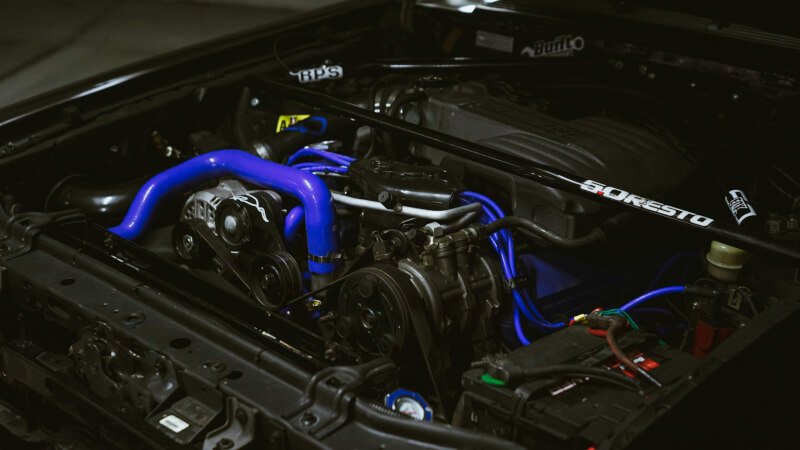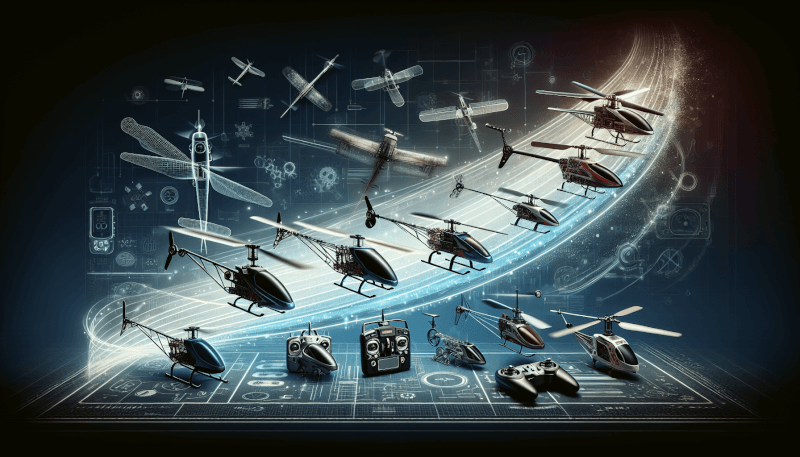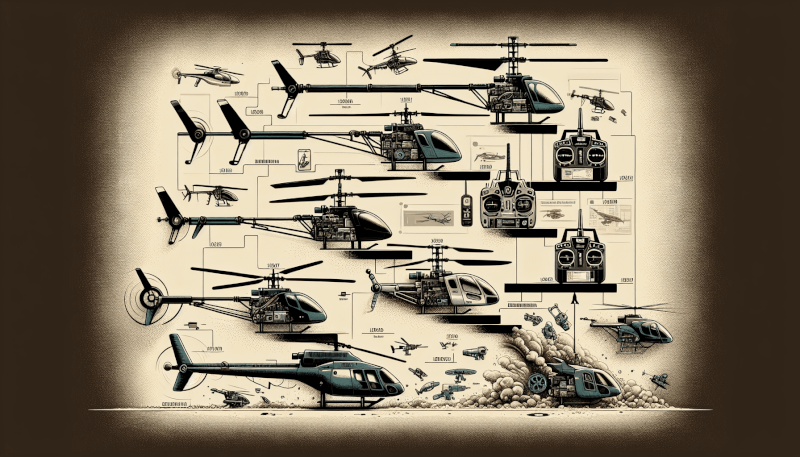Imagine yourself flying high above the ground, effortlessly navigating through the air with precision and control. What once seemed like a mere fantasy has become a reality thanks to the incredible advancements in RC helicopter technology. From simple remote-controlled toys to sophisticated aerial machines, these miniature aircraft have come a long way since their humble beginnings. In this article, we will take a fascinating journey through time, tracing the evolution of RC helicopter technology and exploring the groundbreaking innovations that have revolutionized this exhilarating hobby. Get ready to be amazed by the incredible feats achieved by these tiny flying marvels.

Early Developments
Invention of the first RC helicopter
The invention of the first RC helicopter can be attributed to the creativity and ingenuity of Arthur M. Young. In 1942, Young successfully developed and flew the world’s first radio-controlled helicopter. His innovative design consisted of a simple rotor assembly powered by a gasoline engine. This groundbreaking achievement paved the way for the future development and evolution of RC helicopter technology.
Use of mechanical controls
During the early years of RC helicopter development, mechanical controls played a crucial role in enabling flight. These controls, consisting of mechanical linkages and servos, allowed pilots to manipulate the helicopter’s movements with precision. While effective, mechanical controls required a significant amount of skill and finesse to operate, making RC helicopter flying a challenging endeavor.
Crude flight capabilities
Although the early RC helicopters featured crude flight capabilities compared to modern counterparts, they marked the beginning of a revolution in remote control aviation. These early models could achieve basic flight maneuvers such as hovering, forward and backward flights, as well as limited lateral movements. Despite their simplicity, these early achievements laid the foundation for future advancements in RC helicopter technology.
Advances in Controls
Introduction of radio-controlled systems
One of the most significant advancements in RC helicopter technology was the introduction of radio-controlled systems. By replacing the mechanical controls with radio signals, pilots gained greater control and freedom in maneuvering their aircraft. This development not only enhanced the flying experience but also opened up possibilities for more sophisticated flight capabilities and automation.
Development of proportional controls
Proportional controls marked another milestone in the evolution of RC helicopter technology. These controls allowed for finer and more precise adjustments to be made, enabling pilots to perform complex flight maneuvers with greater accuracy. With proportional controls, RC helicopter enthusiasts could showcase their skills in aerobatics and 3D flying, taking the excitement and challenge of remote control aviation to new heights.
Improvements in stability
As RC helicopter technology progressed, manufacturers made significant strides in improving stability during flight. Through advancements in design and engineering, stability-enhancing features such as gyroscopes and flybar systems were introduced. These innovations greatly reduced the inherent instability of RC helicopters, making them more accessible to beginners and ensuring smoother flight experiences for pilots of all skill levels.
Miniaturization
Shrinking of components and size
Miniaturization played a crucial role in the evolution of RC helicopters. As technology advanced, manufacturers focused on shrinking the size of various components, such as motors, servos, and flight controllers. This allowed for more compact and lightweight helicopter designs, which ultimately led to improved maneuverability and flight performance.
Introduction of micro RC helicopters
The introduction of micro RC helicopters revolutionized the hobby by offering enthusiasts the ability to fly indoors and in smaller outdoor spaces. Micro RC helicopters, often no larger than a hand, utilized the advancements in miniaturization to deliver impressive flight capabilities in a tiny package. These miniature marvels enabled pilots to perform intricate maneuvers in confined areas, introducing a new level of excitement and versatility to the hobby.
Advantages and challenges of miniaturization
Miniaturization brought numerous advantages to RC helicopters. Smaller aircraft meant increased portability and convenience for pilots, allowing them to enjoy the hobby in various locations. Furthermore, the reduced size reduced the risk of damage during crashes, making flying more forgiving for beginners and less costly for enthusiasts. However, miniaturization also posed challenges, as smaller components often required more precise manufacturing and assembly, pushing the boundaries of technological capabilities.
Electric Power
Transition from gas-powered to electric-powered helicopters
One of the most significant transitions in RC helicopter technology was the shift from gas-powered to electric-powered helicopters. Electric power systems offered numerous advantages over their gas counterparts, including quieter operation, cleaner emissions, and improved efficiency. This transition also reduced the maintenance requirements and offered more consistent performance during flights.
Advantages of electric power systems
Electric power systems brought several advantages to RC helicopters. Firstly, they eliminated the need for fuel, making it more cost-effective and environmentally friendly to operate. Secondly, electric motors provided instant and consistent power delivery, resulting in improved flight performance and responsiveness. Lastly, the absence of a combustion engine reduced the noise level, making electric RC helicopters more suitable for flying in residential areas and noise-sensitive environments.
Efficiency and performance improvements
Electric power systems allowed for significant improvements in efficiency and performance. The shift to electric motors, combined with advancements in battery technology, increased flight times and reduced charging intervals. Additionally, the availability of brushless motors and lithium polymer batteries provided higher power-to-weight ratios, enabling RC helicopters to achieve more aggressive flight maneuvers and enhanced aerobatic capabilities.

Flybarless Technology
Elimination of traditional flybar systems
Flybarless technology brought a revolutionary change to RC helicopter design and flight control. Traditionally, RC helicopters utilized flybar systems to enhance stability and manage interactions between the rotor system and the fuselage. However, with the advent of electronic stabilization systems, flybars became obsolete, making way for more streamlined and efficient designs.
Introduction of electronic stabilization systems
Electronic stabilization systems, commonly known as flybarless systems, replaced traditional flybars by employing gyroscopes and advanced algorithms to stabilize the helicopter during flight. These systems continuously monitor and adjust the rotor blades’ movements, ensuring precise and balanced flight characteristics. By eliminating flybars, RC helicopter manufacturers were able to simplify the design, reduce mechanical complexity, and improve overall performance.
Enhanced agility and responsiveness
The introduction of flybarless technology brought about enhanced agility and responsiveness in RC helicopters. Without the limitations imposed by mechanical flybars, helicopters became more maneuverable, allowing pilots to perform a wide range of complex aerobatic maneuvers with greater precision. The increased agility and responsiveness of flybarless helicopters added a new dimension of excitement and challenge for both aspiring and experienced RC helicopter pilots.
Brushless Motors and Lithium Polymer Batteries
Introduction of high-performance brushless motors
The adoption of brushless motors represented a significant advancement in RC helicopter power systems. Brushless motors, compared to their brushed counterparts, offered increased power output, improved efficiency, and reduced maintenance requirements. These high-performance motors played a pivotal role in unlocking the full potential of RC helicopters, allowing for more impressive flight maneuvers and higher overall performance.
Advantages of brushless motors over brushed motors
Brushless motors offered several advantages over brushed motors. Firstly, they eliminated the need for brushes and commutators, resulting in reduced friction and wear, ultimately extending the motors’ lifespan. Secondly, brushless motors generated less heat and produced smoother power delivery, making them more reliable and efficient. Lastly, the absence of brushes avoided the associated electrical noise, ensuring quieter operation and a better flying experience.
Benefits of lithium polymer batteries
The introduction of lithium polymer (LiPo) batteries brought significant benefits to RC helicopter enthusiasts. LiPo batteries offered higher energy density, allowing for lighter weight and increased flight times. Furthermore, LiPo batteries provided more consistent power throughout the entire discharge cycle, ensuring stable flight performance until the batteries were depleted. The improved energy storage and superior power output of LiPo batteries significantly enhanced the overall flight experience for RC helicopter pilots.

Advanced Flight Modes
Introduction of 3D flight modes
The introduction of 3D flight modes marked another significant milestone in RC helicopter technology. With 3D flight modes, pilots could perform a wide array of complex aerobatic maneuvers, including flips, rolls, and inverted flight. These advanced flight modes required precise control inputs and technical proficiency, pushing the boundaries of what was previously thought possible in remote control aviation.
Autonomous flight capabilities
Advancements in technology have facilitated the introduction of autonomous flight capabilities in RC helicopters. This technology allows RC helicopters to automatically stabilize themselves in flight, maintain a set altitude, or even follow a pre-determined flight path. Autonomous flight capabilities eliminate the need for constant manual control, providing pilots with a hands-free experience, and opening up possibilities for automated aerial inspections, mapping, and other practical applications.
Implementation of GPS navigation systems
GPS navigation systems have emerged as a key feature in modern RC helicopter technology. These systems enable helicopters to accurately determine their position and altitude, providing precise navigation and waypoint capabilities. With GPS integration, pilots can program their helicopters to fly to specific locations autonomously, perform complex missions, or even return to a designated home point automatically. GPS navigation systems offer new perspectives and opportunities for RC helicopter pilots, expanding the range of applications and possibilities in the hobby.
First-person View (FPV) and Video Recording
Integration of cameras for FPV
The integration of cameras into RC helicopters introduced a whole new dimension to the flying experience. With the advent of miniaturized cameras, pilots could enjoy a first-person view (FPV) of their helicopter’s flight, immersing themselves in the pilot’s perspective. FPV cameras, typically mounted on the helicopter’s frame or under the nose, transmit live video feeds to a ground station or a pair of FPV goggles, allowing pilots to see and navigate from the helicopter’s point of view.
Improvements in video transmission technology
Advancements in video transmission technology have significantly improved the quality and range of FPV systems. Modern RC helicopters can now transmit high-definition video streams in real-time, offering clear and immersive visuals to the pilot. Additionally, advancements in signal strength and reliability have minimized signal dropouts and interference, ensuring a seamless and uninterrupted FPV experience.
Applications in aerial photography and videography
The integration of cameras and FPV systems has revolutionized the field of aerial photography and videography. RC helicopters equipped with high-quality cameras can capture stunning aerial images and videos from unique perspectives. This technology has found applications in various industries, including filmmaking, real estate, surveying, and search and rescue operations. The ability to capture breathtaking aerial shots has empowered RC helicopter enthusiasts to explore their creativity and contribute to the art and science of photography and videography.

Smart Features
Integration of gyroscopes and accelerometers
Gyroscopes and accelerometers have become integral components of modern RC helicopters, enabling advanced stability and control capabilities. These sensors continuously monitor the helicopter’s orientation, rotation, and movement, providing real-time data to the flight controller. By utilizing this information, the flight controller can make rapid and precise adjustments to maintain stability, optimize flight performance, and compensate for external factors such as wind gusts.
Use of advanced sensors for stability and control
In addition to gyroscopes and accelerometers, modern RC helicopters incorporate advanced sensors to further enhance stability and control. Some of these sensors include altimeters, barometers, and magnetometers. Altimeters provide accurate altitude measurements, allowing for precise control and navigation, while barometers measure atmospheric pressure to estimate changes in altitude. Magnetometers, on the other hand, help determine the helicopter’s orientation relative to the Earth’s magnetic field. The integration of these advanced sensors ensures a more robust and reliable flight experience.
Auto-hover and auto-land functionalities
Auto-hover and auto-land functionalities have become staple features in modern RC helicopters, providing pilots with additional convenience and safety. With auto-hover, the helicopter can automatically maintain a stable hover, allowing pilots to focus on other tasks or capture aerial footage without worrying about maintaining position manually. Auto-land functionality enables the helicopter to safely land autonomously, reducing the risk of crash landings and ensuring a controlled descent in case of emergencies. These smart features offer peace of mind to pilots and contribute to a more user-friendly and enjoyable flying experience.
Future Trends
Continued miniaturization and improved power-to-weight ratios
The trend of continued miniaturization in RC helicopter technology is expected to persist. As advancements in materials, manufacturing processes, and electronics continue, RC helicopters will become even smaller, lighter, and more agile. This miniaturization will also be accompanied by improvements in power-to-weight ratios, allowing for even more impressive flight capabilities and aerobatic maneuvers. Pilots can look forward to pushing the limits of what is possible with these compact and powerful machines.
Integration of artificial intelligence and machine learning
The integration of artificial intelligence (AI) and machine learning is poised to be a game-changer in RC helicopter technology. AI algorithms can analyze large quantities of flight data, enabling helicopters to adapt and optimize their flight characteristics in real-time. Machine learning algorithms can also help improve flight performance by fine-tuning control inputs based on pilot preferences and flying styles. These advancements will assist pilots in achieving greater precision, stability, and efficiency, making RC helicopter flying more accessible and enjoyable for enthusiasts of all skill levels.
Emergence of autonomous swarm systems
The future of RC helicopter technology may see the emergence of autonomous swarm systems, where multiple helicopters can communicate and cooperate in complex missions. These systems could utilize AI algorithms to coordinate their actions, allowing for intricate aerial formations, search patterns, or collaborative tasks. Autonomous swarm systems could find applications in industries such as surveillance, agriculture, and disaster response, where the collective capabilities of a swarm of RC helicopters could provide efficiency and effectiveness beyond what a single aircraft can achieve.
In conclusion, the evolution of RC helicopter technology has been a remarkable journey marked by numerous advancements and innovations. From the invention of the first RC helicopter to the integration of artificial intelligence, these technological developments have continuously pushed the boundaries of what is possible in remote control aviation. As RC helicopter enthusiasts continue to explore the skies, we can eagerly anticipate future developments that will further enhance the excitement, accessibility, and versatility of this exhilarating hobby.



